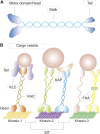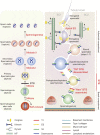Kinesins in Mammalian Spermatogenesis and Germ Cell Transport
- PMID: 35547823
- PMCID: PMC9083010
- DOI: 10.3389/fcell.2022.837542
Kinesins in Mammalian Spermatogenesis and Germ Cell Transport
Abstract
In mammalian testes, the apical cytoplasm of each Sertoli cell holds up to several dozens of germ cells, especially spermatids that are transported up and down the seminiferous epithelium. The blood-testis barrier (BTB) established by neighboring Sertoli cells in the basal compartment restructures on a regular basis to allow preleptotene/leptotene spermatocytes to pass through. The timely transfer of germ cells and other cellular organelles such as residual bodies, phagosomes, and lysosomes across the epithelium to facilitate spermatogenesis is important and requires the microtubule-based cytoskeleton in Sertoli cells. Kinesins, a superfamily of the microtubule-dependent motor proteins, are abundantly and preferentially expressed in the testis, but their functions are poorly understood. This review summarizes recent findings on kinesins in mammalian spermatogenesis, highlighting their potential role in germ cell traversing through the BTB and the remodeling of Sertoli cell-spermatid junctions to advance spermatid transport. The possibility of kinesins acting as a mediator and/or synchronizer for cell cycle progression, germ cell transit, and junctional rearrangement and turnover is also discussed. We mostly cover findings in rodents, but we also make special remarks regarding humans. We anticipate that this information will provide a framework for future research in the field.
Keywords: apical ectoplasmic specialization; blood-testis barrier; cell junctions; cytoskeleton; kinesin; sertoli cells; spermatogenesis; testis.
Copyright © 2022 Yao, Qu, Han, Cheng and Xiao.
Conflict of interest statement
The authors declare that the research was conducted in the absence of any commercial or financial relationships that could be construed as a potential conflict of interest.
Figures



Similar articles
-
KIF15 supports spermatogenesis via its effects on Sertoli cell microtubule, actin, vimentin, and septin cytoskeletons.Endocrinology. 2021 Apr 1;162(4):bqab010. doi: 10.1210/endocr/bqab010. Endocrinology. 2021. PMID: 33453102 Free PMC article.
-
Transport of germ cells across the seminiferous epithelium during spermatogenesis-the involvement of both actin- and microtubule-based cytoskeletons.Tissue Barriers. 2016 Nov 28;4(4):e1265042. doi: 10.1080/21688370.2016.1265042. eCollection 2016. Tissue Barriers. 2016. PMID: 28123928 Free PMC article. Review.
-
Regulation of spermatogenesis by a local functional axis in the testis: role of the basement membrane-derived noncollagenous 1 domain peptide.FASEB J. 2017 Aug;31(8):3587-3607. doi: 10.1096/fj.201700052R. Epub 2017 May 9. FASEB J. 2017. PMID: 28487282 Free PMC article.
-
Disruption of Sertoli-germ cell adhesion function in the seminiferous epithelium of the rat testis can be limited to adherens junctions without affecting the blood-testis barrier integrity: an in vivo study using an androgen suppression model.J Cell Physiol. 2005 Oct;205(1):141-57. doi: 10.1002/jcp.20377. J Cell Physiol. 2005. PMID: 15880438
-
Extracellular matrix: recent advances on its role in junction dynamics in the seminiferous epithelium during spermatogenesis.Biol Reprod. 2004 Aug;71(2):375-91. doi: 10.1095/biolreprod.104.028225. Epub 2004 Apr 28. Biol Reprod. 2004. PMID: 15115723 Review.
Cited by
-
Whole-transcriptome sequencing analysis to identify key circRNAs, miRNAs, and mRNAs in the development of yak testes.BMC Genomics. 2024 Sep 2;25(1):824. doi: 10.1186/s12864-024-10716-1. BMC Genomics. 2024. PMID: 39223454 Free PMC article.
-
Involvement of kinesins in skeletal dysplasia: a review.Am J Physiol Cell Physiol. 2024 Aug 1;327(2):C278-C290. doi: 10.1152/ajpcell.00613.2023. Epub 2024 Apr 22. Am J Physiol Cell Physiol. 2024. PMID: 38646780 Free PMC article. Review.
-
Mouse SPAG6L, a Key Cytoskeleton Modulator Essential for Male Germ Cell Development, Is Not Required for Sertoli Cell Function.Cells. 2025 May 26;14(11):783. doi: 10.3390/cells14110783. Cells. 2025. PMID: 40497959 Free PMC article.
-
In search of the genetic variants of human sex ratio at birth: was Fisher wrong about sex ratio evolution?Proc Biol Sci. 2024 Oct;291(2033):20241876. doi: 10.1098/rspb.2024.1876. Epub 2024 Oct 16. Proc Biol Sci. 2024. PMID: 39406345
-
Exploring the evolving function of soluble intercellular adhesion molecule-1 in junction dynamics during spermatogenesis.Front Endocrinol (Lausanne). 2024 Jan 8;14:1281812. doi: 10.3389/fendo.2023.1281812. eCollection 2023. Front Endocrinol (Lausanne). 2024. PMID: 38260159 Free PMC article. Review.
References
-
- Aguado-Fraile E., Ramos E., Sáenz-Morales D., Conde E., Blanco-Sánchez I., Stamatakis K., et al. (2012). miR-127 Protects Proximal Tubule Cells against Ischemia/reperfusion: Identification of Kinesin Family Member 3B as miR-127 Target. PLoS One 7 (9), e44305. 10.1371/journal.pone.0044305 - DOI - PMC - PubMed
Publication types
LinkOut - more resources
Full Text Sources

